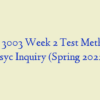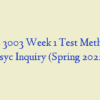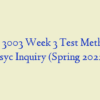Description
PSYC 3003 Week 5 Quiz
- The Pearson product-moment correlation coefficient is used to assess the association between
- Having more than two levels of the independent variable is necessary to
- Which of the following provides a visual image of the relationship between two quantitative variables?
- Which of the following represents the null hypothesis about the means of the dependent variable in a one-way ANOVA with two levels?
- Which of the following variables a”ects only the outcome variable but not the predictor variable?
- Which of the following are necessary in an experimental design?
- In an experimental design, the group that is not exposed to the manipulation of the independent variable is known as which of the following?
- In correlational research design, Jonas finds that r = .82. Jonas’s data demonstrates which of the following?
- Experimental designs are called one-way designs if they have
- An experiment is testing the e”ect of violent radio broadcasts on aggressive behavior. Each participant listens to a violent broadcast and then completes a survey. The participant then listens to a non-violent radio broadcast and completes a second survey. This is an example of a
- The goal of the ANOVA is to
- In order to compare the means of levels of task performance when the mood state is manipulated experimentally, a researcher would likely use which of the following statistical tests?
- Daniel is testing thee”ects of watching cartoons on children’s play. He has one group watch violent cartoons and another one watch non-violent cartoons. He then measures the children’s aggressive play behaviors. What is the dependent variable in this experiment?
- Which of the following topics would be most appropriate to study as an independent variable in an experimental design?
- Which of the following is true about correlational research designs?
- Which of the following statements is true?
- Consider the following relationship between violent material and aggressive behavior: Violent TV > arousal > aggressive behavior. In this case, arousal can be described as a
- One difficulty of repeated-measures designs is that, due to the possibility of fatigue, practice, or carryover, the researcher may need to use
- Which of the following is used to be certain that the participants in the di”erent conditions of a research design are, on average, equivalent before the experiment begins?
- The level of the independent variable in which the situation of interest was created is frequently known as which of the following?
- Which of the following is a table showing the correlations of many variables with each other?
- In a multiple regression analysis, which of the following are most similar to correlation coefficients?
- Reciprocal causation occurs when
- When conducting statistical analyses in experimental design, in order to confirm the research hypothesis, the researcher hopes that which of the following is true?
- A repeated-measures design refers to which of the following?
- Which of the following statistics would be used to assess the relationship between two nominal variables?
- A researcher finds that height and intelligence are correlated in children. The age of the child is probably which of the following?
- Jason finds a correlation of .85 between monthly homicide rates and monthly ice cream sales. However, he believes that the correlation is caused by monthly changes in temperature. In this case, temperature represents a(n) variable.
- Daniel is testing the e”ects of watching cartoons on children’s play. He has one group watch violent cartoons and another one watch non-violent cartoons. He then measures the children’s aggressive play behaviors. What are the levels of Daniel’s independent variable?
- Which of the following statements is true?





